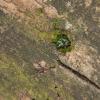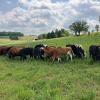With their manicured lawns and neat houses, the suburbs may not seem like welcoming places for wild creatures. Given a chance, though, wildlife will find a way to coexist with people. Suburbs are often less densely developed than older urban centers, and such neighborhoods can be home to a surprising diversity of life thanks to stream corridors, parks, and even yards and gardens. This is the story of one suburban yard, located on a fifty-by-hundred-foot lot, a typical size for the suburbs that have spread westward from Portland, Oregon, across Washington County in recent decades.
When we moved in, the yard was largely grass. At the front of the house there were a handful of azaleas and barberry shrubs in bark chips, along with two oddly placed arborvitae trees, one blocking a window, the other obscuring the front steps. Elsewhere, grass struggled to grow in the shadow of trees or of the house, and in places didn’t grow at all, with the dirt turning to muck in the fall rains. Over time, we’ve gradually created a garden, and in doing so have discovered a diversity of wildlife with which we share our residence.
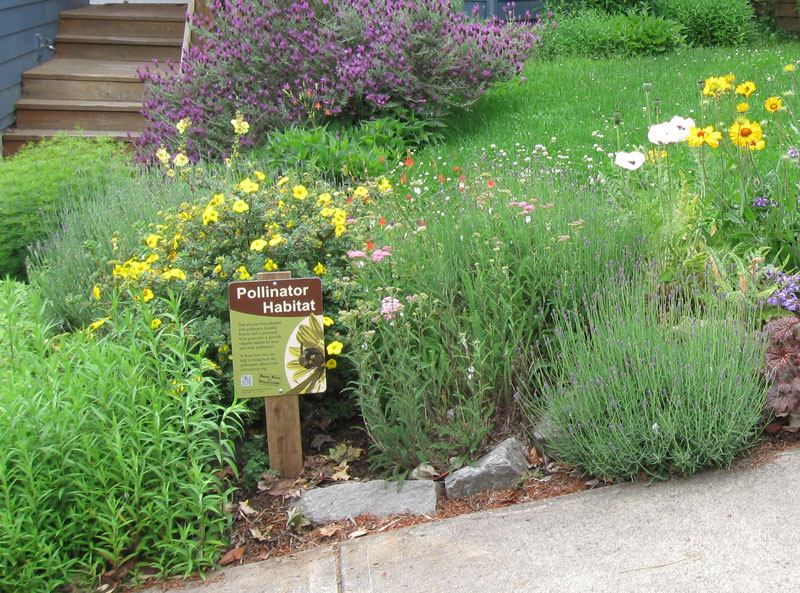
Our house sits in the middle of the lot, separating it into four distinct sections. The front garden faces east; mostly open and sunny, it’s the best area of our yard for flowers. We’ve gradually reduced the amount of grass, replacing it with perennials and shrubs—aster, coneflower, milkweed, goldenrod, California fuschia, blanketflower, phlox, coreopsis, lavender, Oregon grape, wild indigo—a mixture of native and garden varieties that can cope with both wet winters and dry summers with minimal attention, and that offer bloom from late winter to late fall.
Connecting the front garden to the back along the north side of the house is a narrow, shady, damp side yard. For the longest time this was a sheltered spot to store plants waiting for their permanent home, and it was also where we dumped things: the sod removed from the front and back, construction materials for paths, sacks of compost. This passageway has been tidied up in the last couple of years and is now lush with ferns (sword, deer, maidenhair), hellebores, bleeding hearts, and snowberries.
The back garden is very different from the front, tucked under the edge of an acre of Douglas-fir forest. This patch of forest is zoned as neighborhood open space, so is protected from development, and is a remarkable survivor in a region that continues to experience the rapid growth of both housing and business developments. The trees provide the rear of the house with a sense of seclusion. In the heat of summer, the pitchy smell during the day and the rhythmic chirping of tree crickets at night gives it the feel of a wilder place, beyond the suburbs.
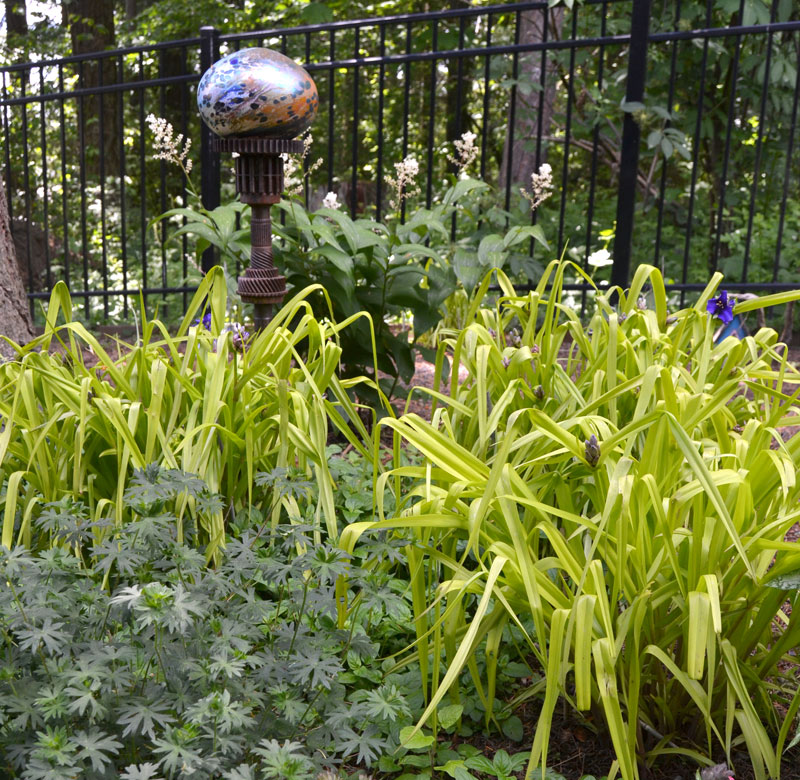
Despite those delights, the forest makes this a tough place to establish plants. Its trees compete for light and moisture in different measures along the back of our small area, part of which is sunny for a few hours, the rest in deep shade. We’ve tried forest plants that found it too sunny and dry, and we’ve tried sun-loving plants that found it too shaded. Through trial and error, we’ve arrived at a selection of plants that can cope with these conditions, and this area, like the front garden, now has a mix of native and garden species. Sword ferns, some self-sown, some planted, lend structure. Color and texture are provided by false Solomon’s seal, wintergreen, yellow wood violet, foam flower, trillium, spiderwort, wild geranium, tiger lily, lungwort, lady’s mantle, lupine, aster, red flowering currant, and Nootka rose. We’ve also got some plants that many people might consider weeds—Siberian miner’s lettuce, wood avens, woodrush, soft rush—forest natives that began growing once we removed the grass.
The fourth section of our garden is the southern margin, isolated from the rest of the front garden by the driveway and extending from the sidewalk to the side of the house, where we keep recycling carts. This strip, in the shelter of a maple tree and shaded by our neighbor’s arborvitae hedge, seldom sees direct sunshine. During the fall, leaves from the maple are raked to the base of the hedge and left to decay. That pile is its own little world, a home to the pillbugs and millipedes that you’d expect, as well as to slugs and snails. As is typical of disturbed areas, the majority of the gastropods in our garden are nonnative; most common are the European red slug (Arion rufus), a rather handsome brown-and-orange beast, and the great grey slug (Limax maximus). The leaf pile, though, is also where we encountered dark-bodied glass snails (Oxychilus draparnaudi), another nonnative species. The glass snails are carnivorous, mainly preying on other invertebrates, although on this occasion a trio of snails were feeding on a dead mouse.
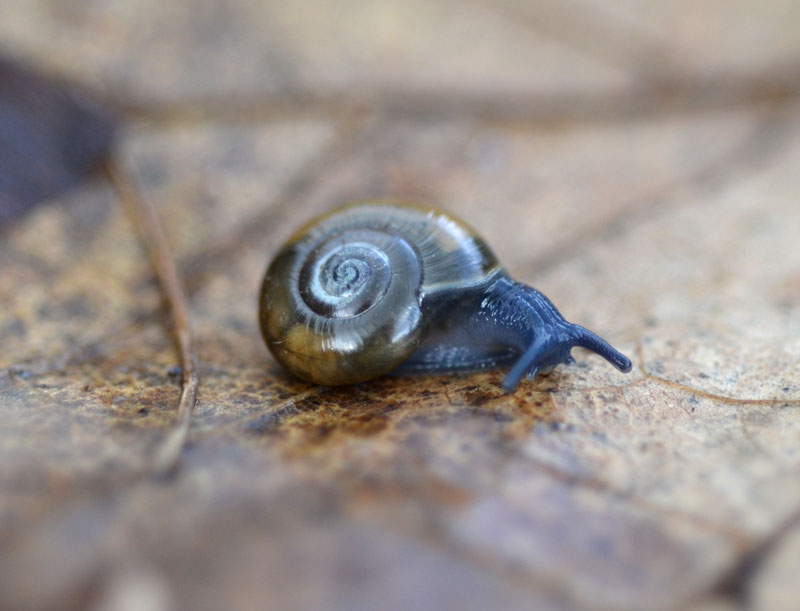
The first bee we see in our garden each year has typically been a blacktail bumble bee, though sometimes a yellow-faced bumble bee will show itself earlier. Whichever, these normally appear between the fifteenth and twentieth of February, although in warm winters they have been seen in January. They forage on the flowers of Oregon grape and lungwort, which fill the gap until French lavender begins to bloom in April. We now have six species of bumble bees (Bombus) recorded for our garden—those two plus blackfaced, fuzzy-horned, yellow-headed, and brown-belted. Other bees we find through the year include mining bees (Andrena) alongside the early bumble bees, and mason bees (Osmia) that show up when the pears and apples blossom. Later in spring, sweat bees in the genera Halictus and Lasioglossum arrive, and in June long-horned bees (Melissodes) appear as the black-eyed Susans come into flower.
Of the more than two dozen species of bees we’ve seen, only two of them are nonnative, the European honey bee (Apis mellifera) and the European wool carder bee (Anthidium manicatum). The wool carder has a close association with one plant, lamb’s ears (Stachys byzantina), a patch of which grows near our front steps. The females nectar on the flowers and collect the downy hairs from the leaves to form their nest cells. The males patrol the lamb’s ears, and chase away any potential competitors for the females. These males will even confront people; they have no stinger, so pose no threat, though if you don’t know this it can be unnerving to have a seemingly aggressive bee hovering in front of your face!
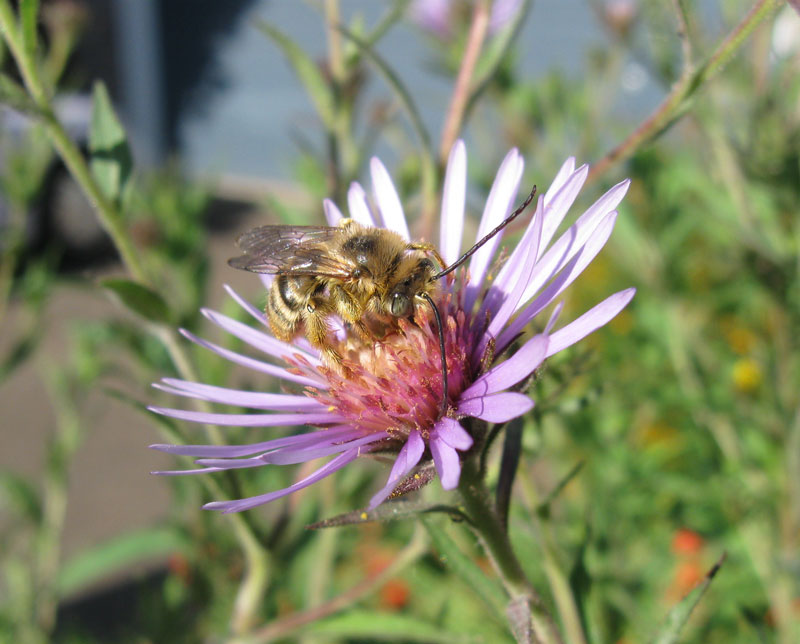
The garden has places without plants, but this bare ground is not barren. Mining bees excavate nests in the plant-free areas. We’ve also watched Nomada cuckoo bees flying to and fro a few inches above the soil in search of mining bee nests in which to lay their eggs. There is a similar pairing of Halictus sweat bees nesting in the ground, and Sphecodes cuckoo bees locating those nests for their own egg laying. Higher up, mason bees and leafcutters (Megachile) occupy bee blocks and other nest structures that we’ve made, and small carpenter bees (Ceratina) have nested in stems of black-eyed Susan left during through the winter.
The bare ground has also hosted solitary wasps in the genus Astata, which stock their nests with stink bugs; and spider wasps (family Pompilidae) scamper frenetically across the dirt, flicking their blue-tinted wings as they hunt for spiders to feed the offspring in their ground nests. Other wasps in the garden include black-and-yellow mud daubers (Sceliphron caementarium), whose nests look like fist-sized lumps of dirt on a wall, and paper wasps (mostly the European species Polistes dominula), which make small nests dangling from the house’s eaves like upside-down mushrooms. Evidence of Polistes nest building is usually more obvious than the wasps themselves. The wasps gather wood fibers from snags or their functional equivalent in the garden landscape—fences, gates, deck rails—leaving tiny scrape marks an eighth of an inch wide and an inch or so long. After chewing those fibers into pulp they use it to form cells with paper-like walls.
Western Oregon is not known as a butterfly hotspot, and this is reflected in the paucity of species in our yard. So far, we have seen only six—as many as we have species of bumble bees—western tiger swallowtail, painted lady, woodland skipper, satyr anglewing, grey hairstreak, and the inevitable cabbage white.
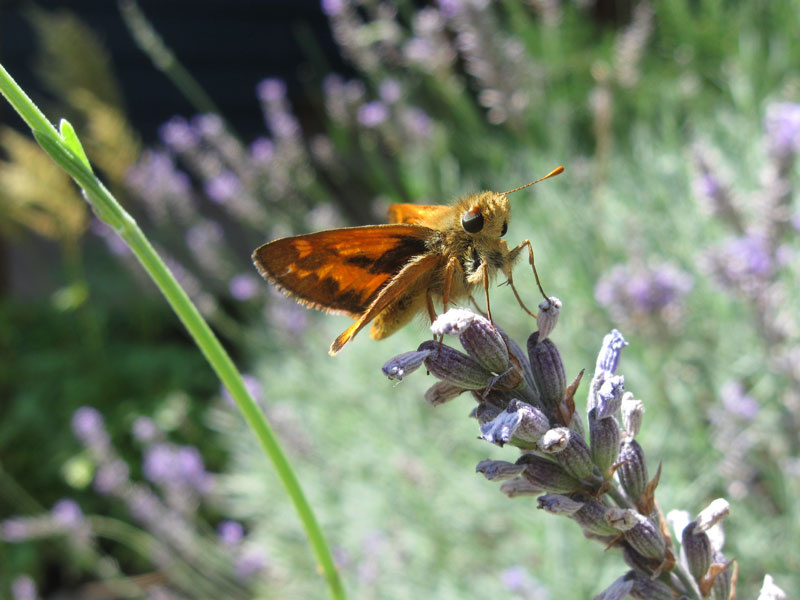
We’ve identified many more moths, and there are certainly a significant number of species that could be added to our garden list; my mothing skills are not great. But because moths are generally an understudied group, even with modest ability there is the chance of significant discoveries. Recently, I found a species of plume moth by the porch light that I’d not seen before. It’s likely either a geranium plume moth (Amblyptilia pica) or an artichoke plume moth (Platyptilia carduidactyla). This sighting has been submitted to Butterflies and Moths of North America, and when its identity is confirmed it could be a new county record.
We haven’t done away with the grass entirely. Some of the front lawn remains as a place for kids to play, for adults to drink coffee in the morning sun, or for both young and old to sit and watch insects with field guide in hand. The lawn has diversified, benign neglect allowing violets, selfheal, and clovers to spread, one more resource for bees. The lawn also provides forage for grasshoppers—red-legged (Melanoplus femurrubrum) in the early summer, and later, when the grass is strawlike, road-dusters (Dissosteira carolina), looking like butterflies as they flit around before abruptly disappearing into the brownness. We have seen a reasonable number of species in our yard (I admit that I’m geeky enough to keep lists!) but we are well aware that the richness of insect life, birds, and mammals is only partly because of our efforts. Everything links with something else over space and time. The acre of Douglas-fir across the back fence, in addition to sheltering us from winter storms, offers host plants for the caterpillars that become the swallowtails that nectar on our tiger lilies, as well as habitat for some insects that we’ve found on our side of the fence and that may not be expected in a typical suburban yard, such as golden jewel beetles (Buprestis aurulenta), snail-hunting Scaphinotus beetles (whose heads and thoraxes are distinctively narrow to enable them to reach inside snail shells), and night-stalking tiger beetles (Omus). The bigleaf maples in the forest support the life cycle of the western boxelder bugs (Leptocoris rubrolineatus) that cluster on the house to warm themselves on sunny winter days.
A few houses away is a stream corridor. There beavers create ponds and wetlands where dragonflies such as the common green darner and striped meadowhawk that hunt over our flowers develop as aquatic nymphs. Ditch sides provide nesting sites for the long-horned bees that forage in our yard. The mining bees that nest in our bare patches forage on the bloom of the creekside willows.
In your own neighborhood, you probably have similar gaps that support wildlife in the midst of development. Even if those less cultivated areas are not immediately over your back fence, you can create the conditions in your garden that will draw wild creatures in and allow you the opportunity for closeup encounters with beautiful—and possibly unexpected—animals.
Further Reading
Learn more about supporting invertebrates in your garden or yard by:



